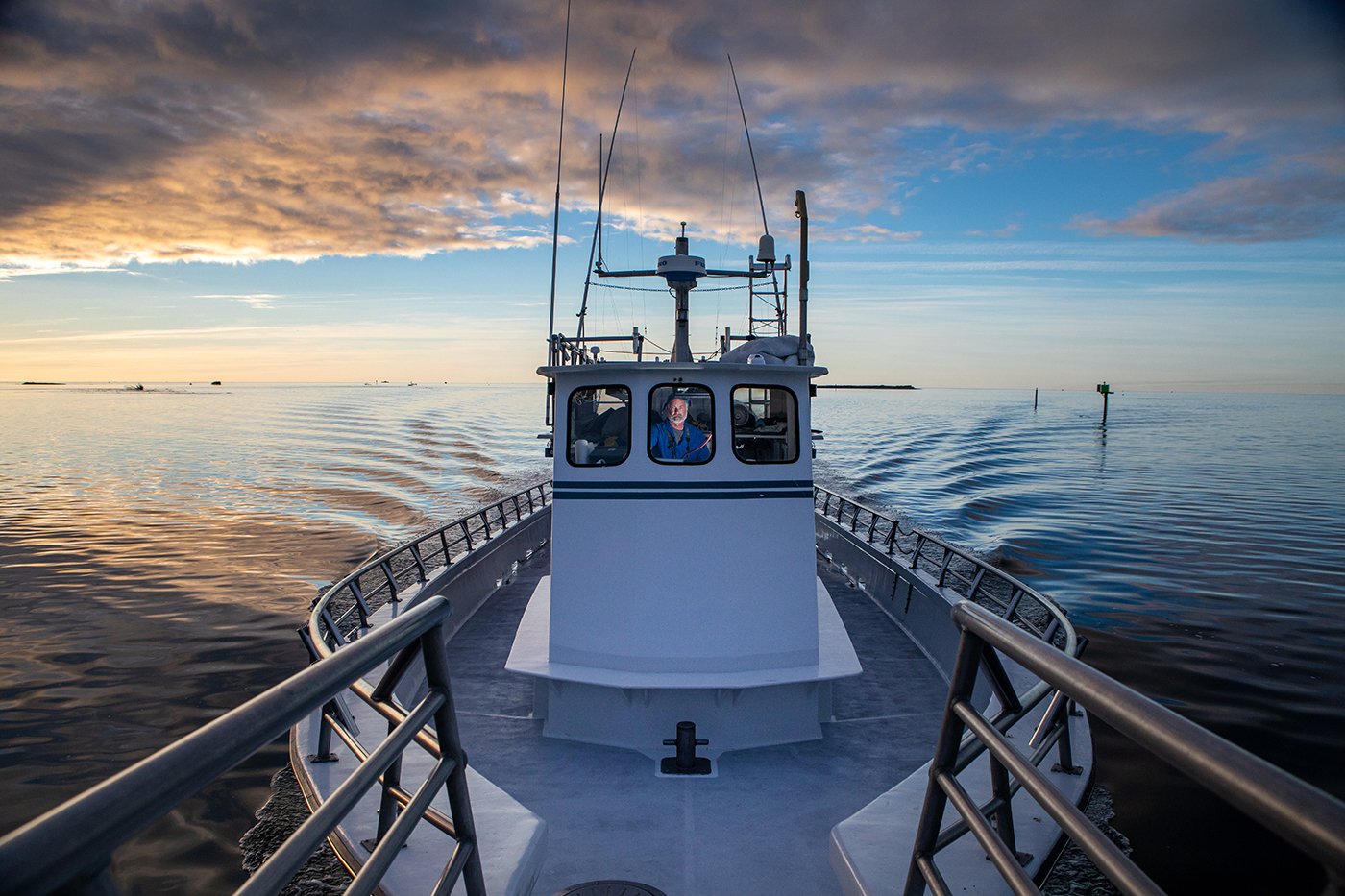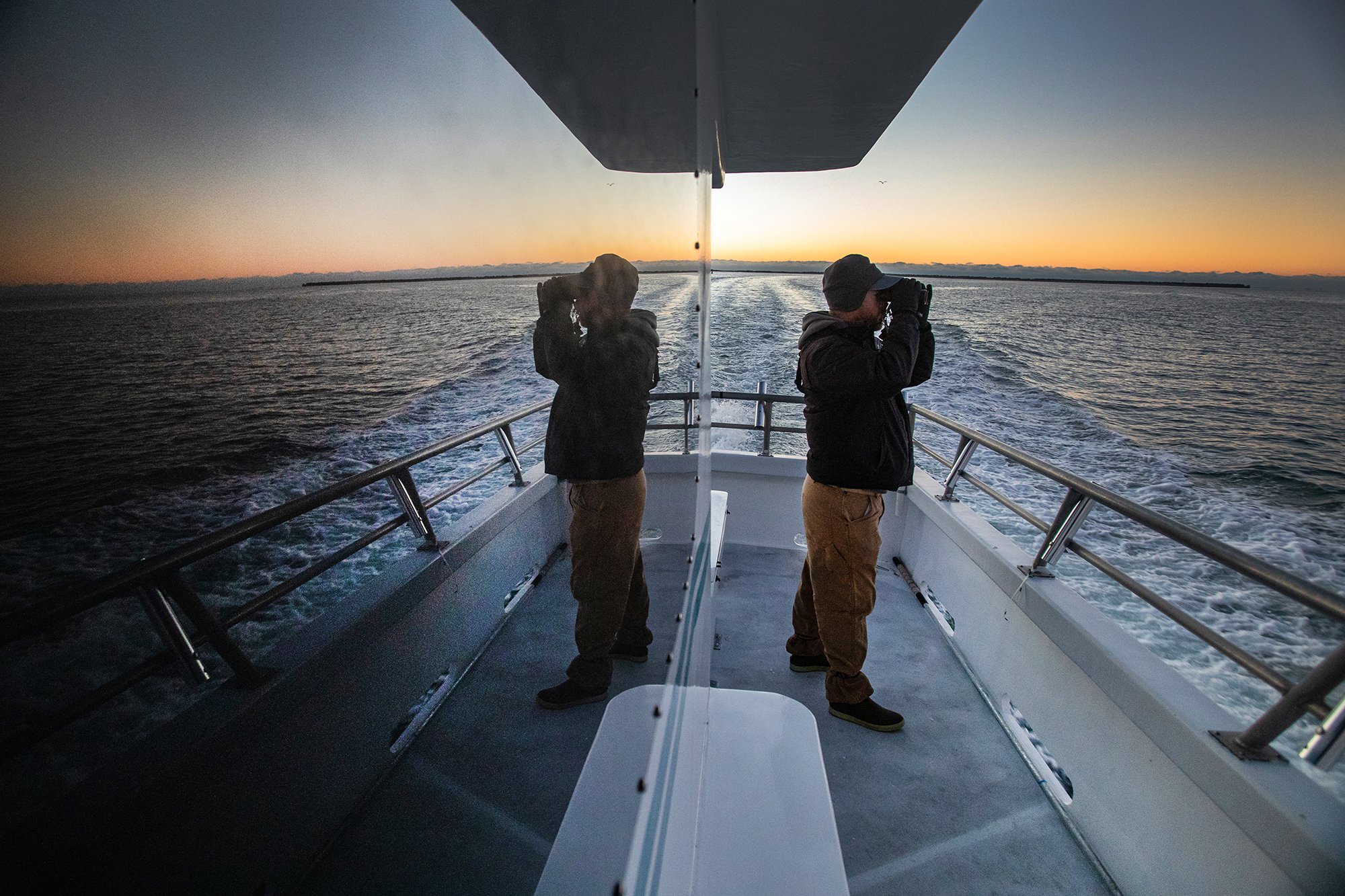Audubon Magazine - Spring 2022
Photography and Video by: Lauren Owens Lambert // Writing by: Kathryn Miles
Off the East Coast, a Massive Network of Wind Turbines Is Coming—Along With New Risks for Migrating Birds
Species journeying over the Atlantic Ocean will soon have to navigate wind farms. But without clean energy, their futures are more imperiled.
The Stormy Petrel II, a 60-foot fishing and seabird touring boat, steamed away from North Carolina’s Outer Banks on a recent winter morning. Its captain, Brian Patteson, is widely considered the godfather of pelagic birds along the Atlantic Seaboard. He was taking me out to find a transient spot along the continental shelf where Northern Gannets gather. By mid-morning I could see a stark delineation in the water off our bow. On one side, emerald, nutrient-rich water cooled by the Labrador Current flowing south from the Arctic; on the other, the midnight blue of the Gulf Stream, the warm, swift current that originates off the tip of Florida.
This boundary is ever shifting off the Outer Banks—sometimes as close as a few miles from the coast, other times as far as 20. Wherever it is, life teems. As we coasted to a corkscrewing bob above the swells, loggerhead turtles floated by, their heart-shaped shells rolling in the current. Below them circled 20 or so hammerhead sharks.
What brought us here was the spectacle off our starboard side. Hundreds of Northern Gannets jostled for space among 3,000 seabirds. Pelicans and gulls scrummed near two shrimp boats, which puttered along churning up fish. The gannets, meanwhile, hovered 30 or 40 feet overhead, occasionally making their trademark daring dive: hurtling toward the water, then tucking their wings in just above the surface as if they were feathers on the shaft of an arrow.
The gannets’ vocalization reached a fever pitch, alerting their kin in the area. Soon a cloud of more than a thousand of the six-foot-wide seabirds amassed around us, shrieking as they whizzed through the air and rained down upon the ocean at dizzying speeds.
Then, as quickly as they arrived, the enormous birds disappeared. “That’s the thing about gannets,” said Patteson, shaking his head. “They don’t think anything about picking up and moving from one state to another in a single day.”
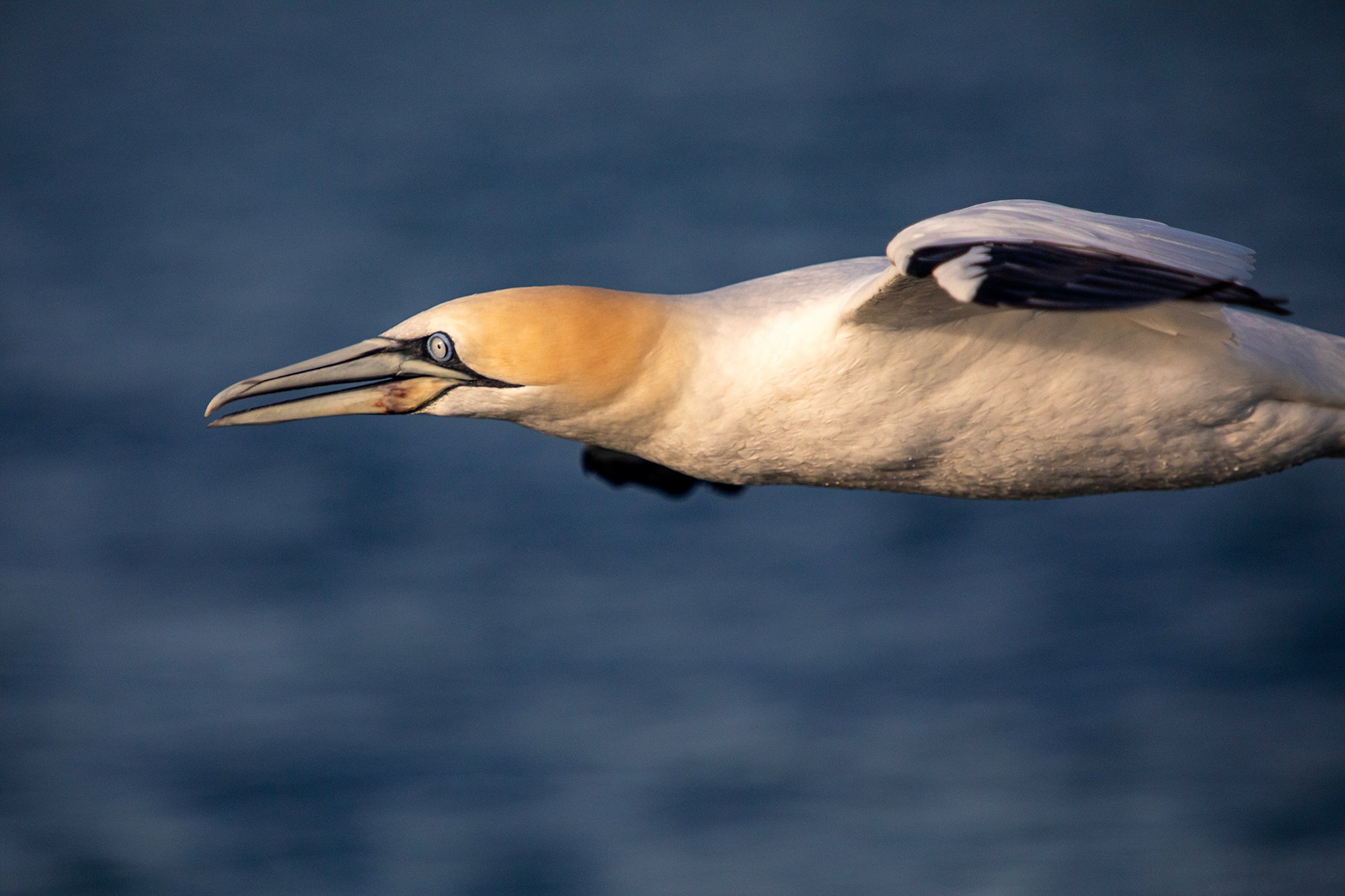
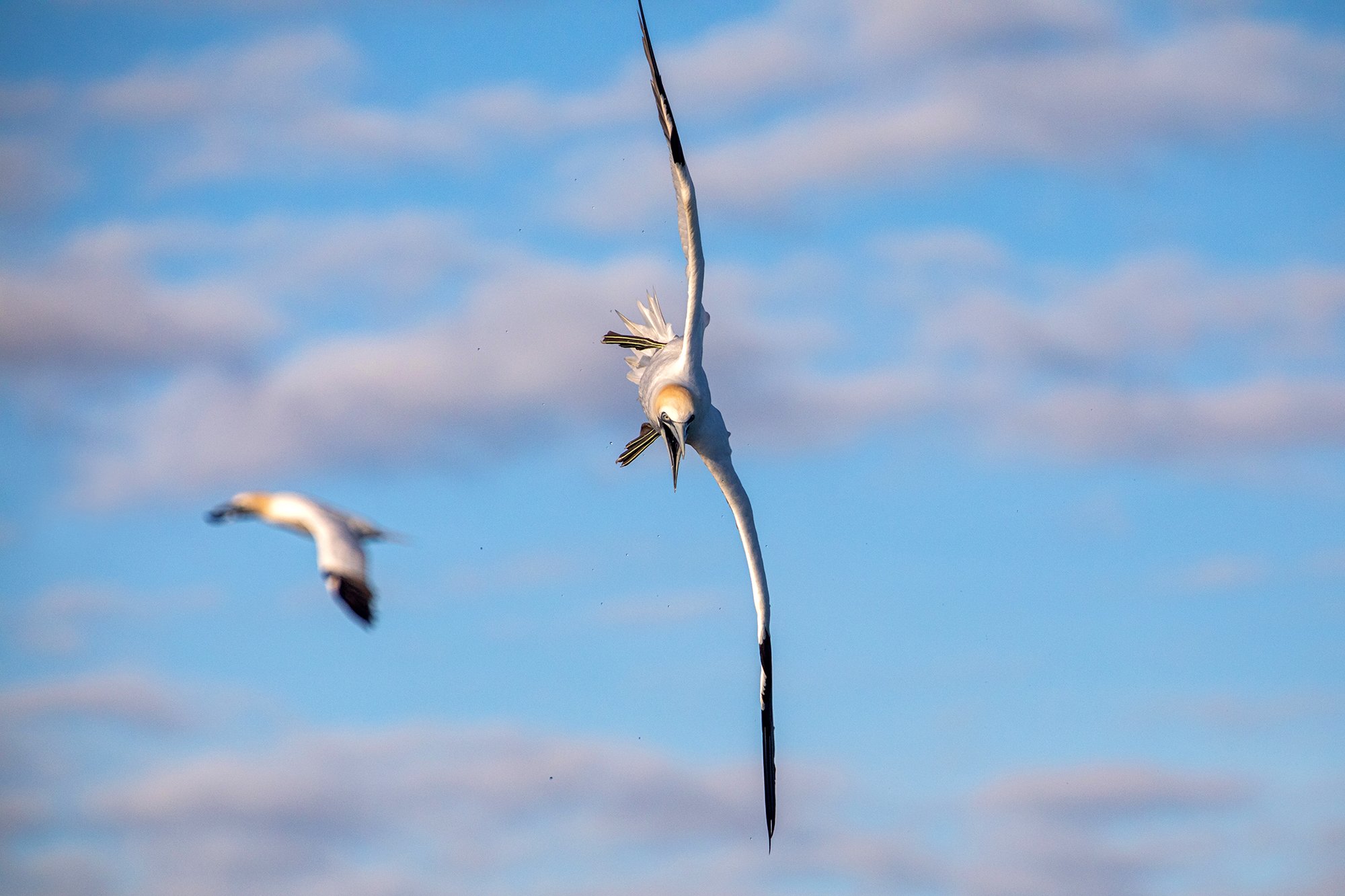


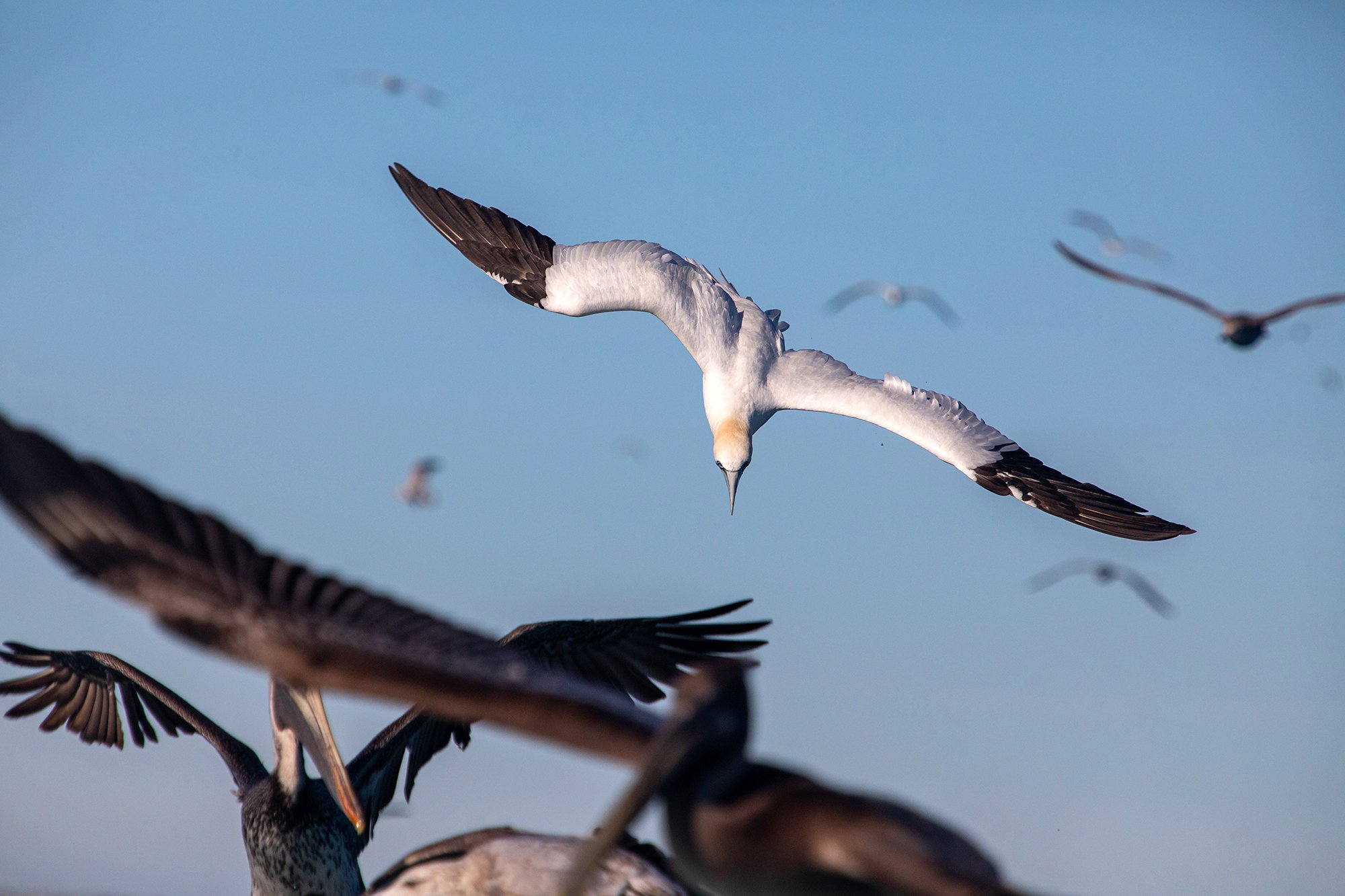

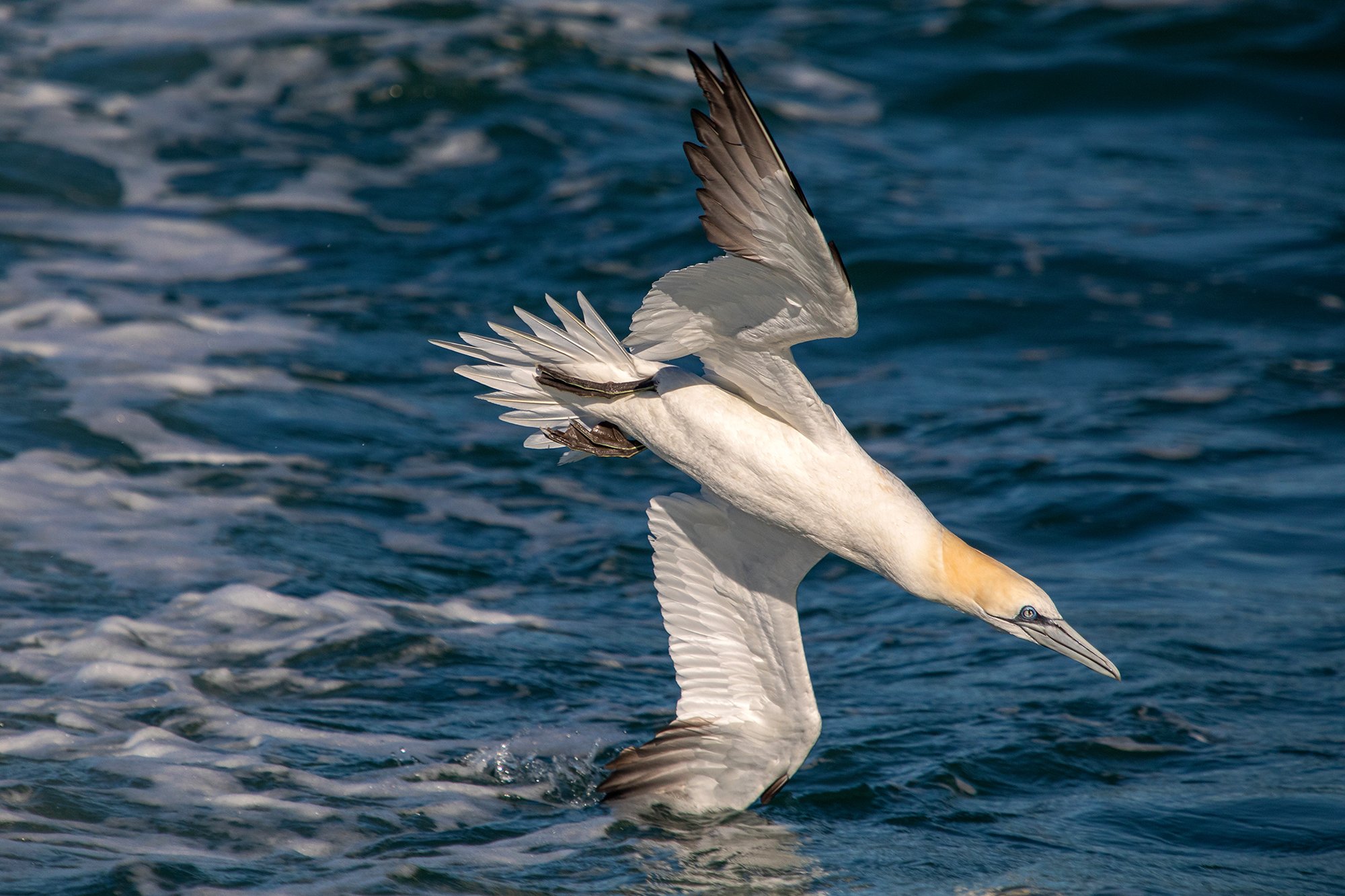


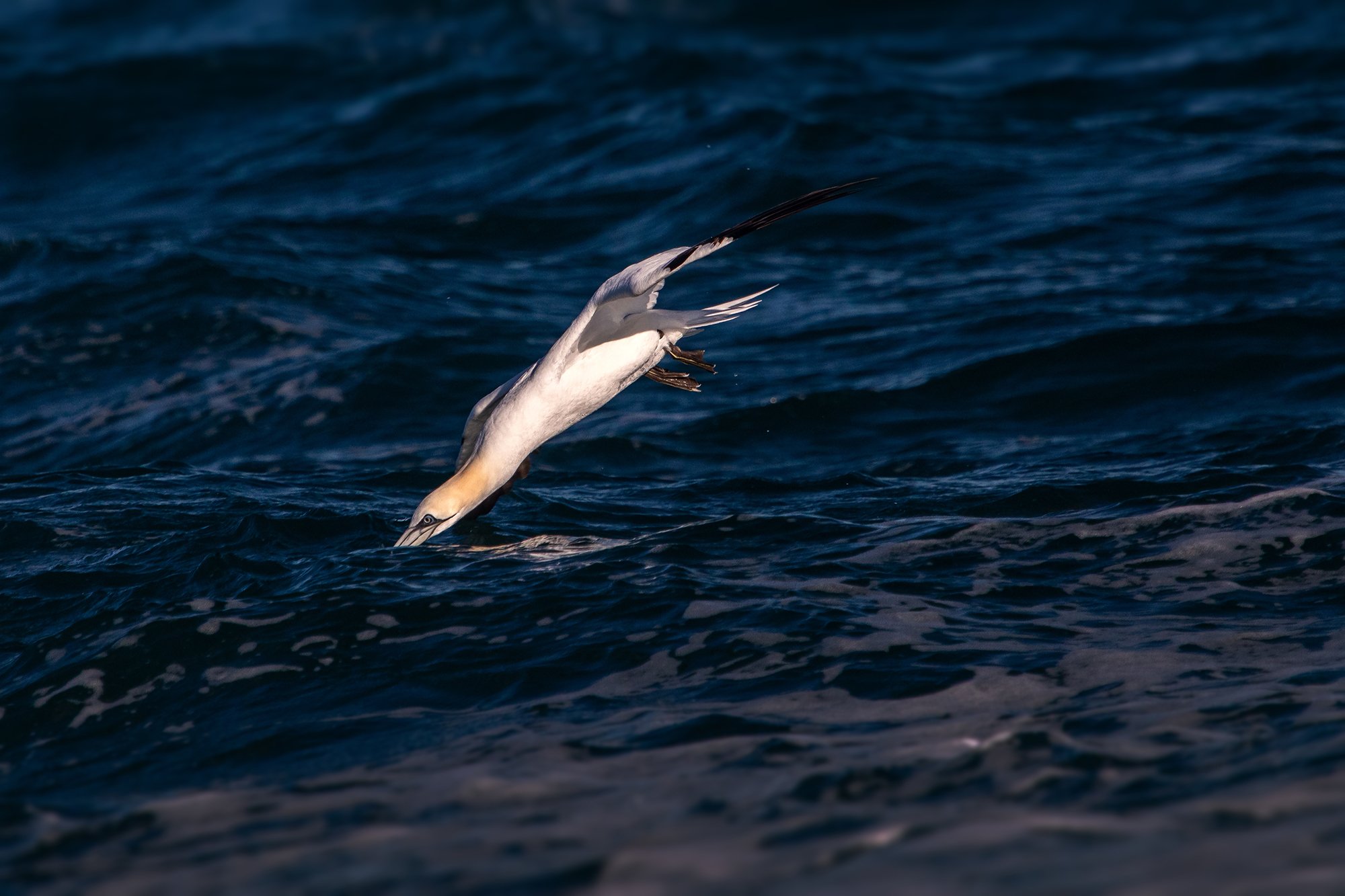
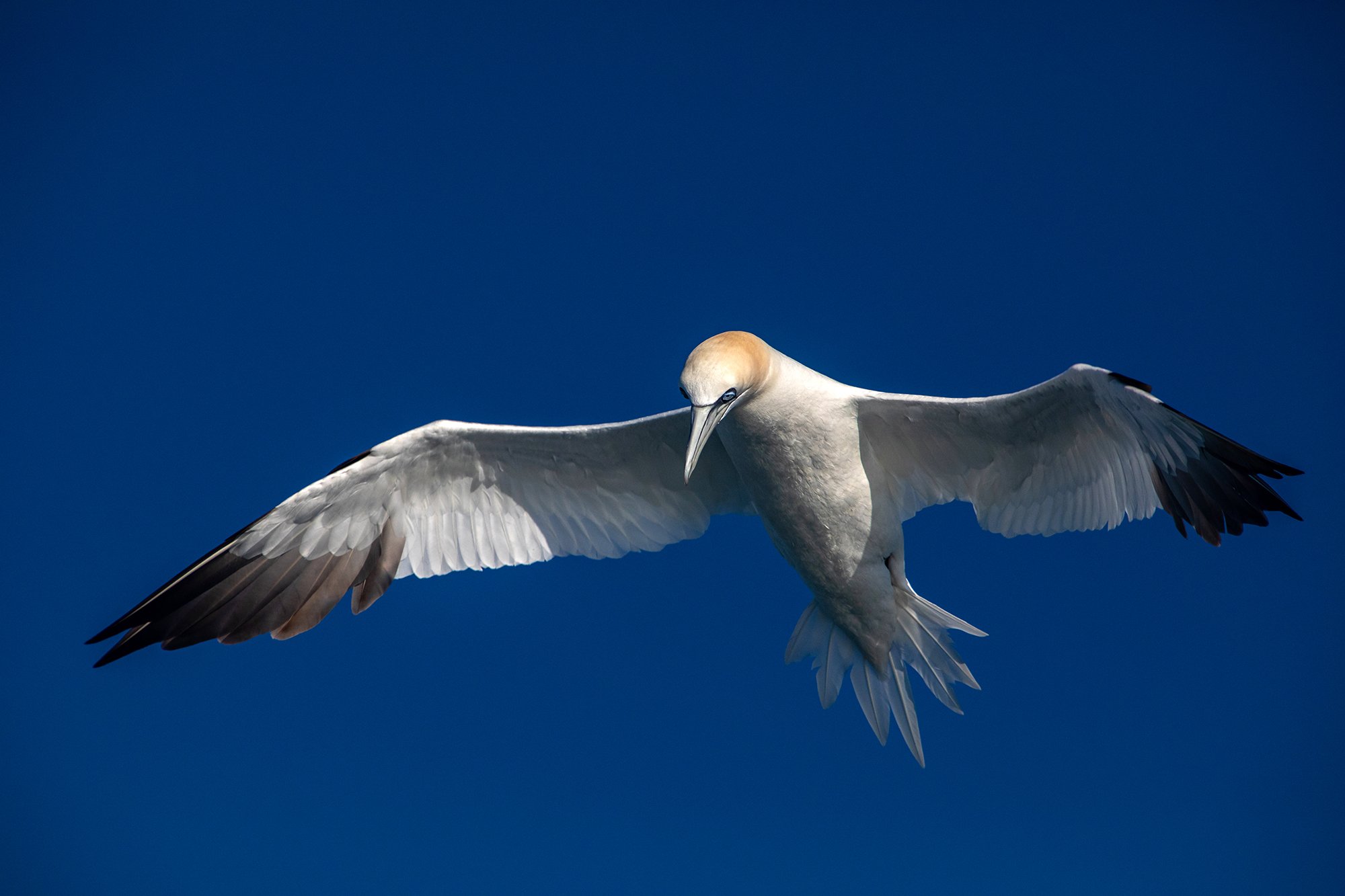
Northern Gannets are built for speed, frequently flying and diving faster than 60 miles an hour. The species spans the North Atlantic; here in North America, gannets breed in six colonies in southern Canada and overwinter at sea from New England to the Gulf of Mexico. They can cover vast distances quickly, and often must, to keep up with the schools of menhaden and other forage fish they pursue.
In the coming years, gannets zipping along the Eastern Seaboard will encounter unprecedented obstacles. In the United States 17 offshore wind sites are under development in the Atlantic, from Cape Cod at the north end down to North Carolina’s Outer Banks, just miles from where Patteson and I observed the gannets’ feeding frenzy. Once completed these wind farms will create a network of turbines along the East Coast continental shelf like nothing else on Earth.
While nobody knows what toll the looming structures might take on seabirds, scientists say gannets may be especially vulnerable. North American populations have stopped expanding over the past decade. Scientists pin the leveling off on warming oceans near their breeding grounds that have altered their prey base. Here, on their wintering grounds, climate change is evident, too. A decade ago Patteson and I would never have seen shrimp boats in January: Back then the North Carolina shrimp harvest was negligible in cold winter waters. Now nearly 40 percent of the annual harvest is caught between December and March. “You can’t help but notice things are changing,” Patteson told me as the Stormy Petrel II headed back to port.
Shifts in the food web, sea-level rise, marine heat waves, and more changes are expected to intensify and accelerate over the coming decades as global temperatures warm. But much damage can still be slowed or even reversed if carbon emissions decline. Doing so will require society-wide changes, including converting U.S. electricity sources from carbon-emitting fossil fuels to clean energy generated by wind and the sun. And so the Northern Gannet, and other bird species, are in an unfortunate bind: They are seriously threatened by climate change, but offshore wind—one of the most aggressively sought correctives—may prove deadly to them, too.
Off the coast of Rhode Island stand the nation’s first five offshore turbines (photographed here during a LightHawk flight). Although smaller in stature than the next generation of turbines, they portend the future of the Atlantic’s offshore waters.
Scientists understand the potential impacts of offshore wind on Northern Gannets better than they do for many other marine animals thanks to research on the species’ interactions with existing wind farms in Europe. They know the technology comes at a cost. But it’s a trade-off many are willing to make.
“Global warming is coming at us so fast we don’t have a choice but to adopt offshore wind,” says wildlife biologist Shilo Felton, field manager for Audubon’s Clean Energy Initiative. “This isn’t even as simple as ‘damned if you do, damned if you don’t.’ Gannets are certainly damned if we don’t.”
The Northern Gannet’s life history is as riveting as an operatic melodrama. The seabirds raise their young in packed colonies on cliffs in the North Atlantic’s upper latitudes—cramped places marked by fierce competition. Gannets will injure or kill each other over nest sites, slicing neighbors or even errant chicks with a rapier-sharp beak. To fledge, chicks hurl themselves off the cliff’s edge, sometimes falling 50 feet before gaining the momentum they need to glide down to the ocean. In the weeks before their flight feathers fully grow in, they bob along ocean currents learning to fish. In optimal years, fat stores buoy the young birds. But lean foraging seasons can cause crisis for young gannets still unable to fly. Those that survive range far and wide along the continental shelf for three or four years in search of prey. By the time they return to the breeding colonies as mature adults, they’re massive and powerful, capable of diving more than 70 feet deep.
That very physiology is, at least in part, what makes them so vulnerable to collisions with turbines. For all their speed and power, gannets suffer from tunnel vision. The binocular view that allows them to spy prey fathoms deep keeps their focus trained on the ocean below rather than on obstacles in front of them. It’s not uncommon to see gannets collide with each other while in a feeding frenzy. That, plus their preference for flying at the same height as a turbine’s rotor sweep zone, has led scientists to suspect that they have an especially high risk among seabirds for fatal collisions.
At the same time, studies have shown that, while some gannets will forage amid turbines, most tend to avoid them altogether—a kind of habitat loss that scientists call “displacement.”
“It seems counterintuitive that gannets could be at both collision and displacement risks,” Felton says, “but research suggests it’s true.”
What remains unknown is how the extra energy spent to avoid the turbines, combined with the potential drop in food availability if they lose all hunting grounds associated with the wind farms, will affect birds like gannets. Scientists assume they will be harmed, but they can’t say how significant those impacts will be.
Those potential future threats pile on top of existing ones. As apex predators, gannets are poisoned by toxins in the food chain, and they are prone to deadly entanglements with ocean debris and fishing nets. William Montevecchi, a biologist at Memorial University in Newfoundland, has studied seabirds, including gannets, for 40 years. He suspects that changes to the food web, induced by warming waters, are the cause of gannets’ reduced breeding success in North America. Mackerel, the species’ preferred food when breeding, is in increasingly short supply. When waters warm, mackerel may swim deeper in the water column, presumably out of range of even the gannet’s impressive dive depths, and leave the area for colder waters.
When food is scarce, it can spell disaster for young birds. A particularly bad season came in 2012, Montevecchi says. Many nests remained empty from the start. Of the eggs laid, only about 40 percent fledged. Chicks were often seen begging for food from parents who returned empty-beaked. Then, one morning in early August, observers near the colony on Cape St. Mary’s in Newfoundland awoke to discover that virtually all adults had abandoned the colony overnight. More than half of the chicks died. Montevecchi and his colleagues suspect that a marine heat wave (a stretch of five or more days of exceptionally warm ocean temperatures), coupled with severe thunderstorms, caused the desertion. Since then, abandonment has become more common on Cape St. Mary’s. In 2014, 2015, and 2018, 20 to 30 percent of breeding adults fled.
Despite this recently rocky record, gannets in North America keep returning to the same colonies. No matter how densely packed or food-scarce the sites become, the birds haven’t made any known attempts to establish new colonies, even when there appears to be suitable habitat nearby.
“It’s such a paradox,” Montevecchi says. “These are probably the most aggressive birds, period. They fight the bloodiest battles and are capable of horrific bloodletting, but they won’t expand beyond these six colonies.”
If the gannets won’t move, even as their breeding habitat and food sources degrade around them, then their best hope lies in our ability to curb emissions and our wider environmental impact.
Coming Soon
Seventeen wind projects under development along the U.S. Atlantic Coast are slated to go online in the next decade.
The scale of these installations is unprecedented across the world. Europe has led the way in offshore wind development, and most of the existing wind farms there, many built in the mid-1990s, are smaller in scope: a dozen or so turbines, each around 100 feet tall and set so close together that their 30-foot rotors create a veritable wall of white when seen from the air. Studies there suggest that wind farms tend to displace auks, including murres, Razorbills, and puffins, as well as Red-throated Loons and many sea ducks. There are practically no data on bird collision risks, but gulls in particular and gannets may be vulnerable, according to limited assessments.
These studies are only so instructive for North American birds, given the notable differences between European projects and the more massive installations planned for the United States. Kate Williams directs the Center for Research on Offshore Wind and the Environment at the Biodiversity Research Institute (BRI), a scientific nonprofit based in Maine. One critical consideration, she says, is the distance between the turbines in European waters. The dense placement creates a barrier effect, such that many birds perceive the wind farm as a single obstacle and avoid it entirely.
Shilo Felton, field manager for Audubon’s Clean Energy Initiative, surveys Rhode Island’s Block Island Wind Farm, the country’s first offshore wind installation.
“Now we’re looking at turbines that are a kilometer apart or more, and it seems very possible that birds would stop seeing the wind farm in its entirety and start responding to individual turbines,” Williams says. “We don’t know because these really big new turbines haven’t been installed anywhere yet.”
Scientists know that dozens of bird species use the offshore wind lease areas, including Blackpoll Warblers, Dunlin, and Ruddy Turnstones that migrate over the Atlantic. These areas have high wind speeds, moderate water depths, and a solid seafloor—characteristics that make good hunting grounds for birds like the gannet. While individual birds have been tagged, there’s a dearth of data showing where most birds go and the altitudes at which they fly. Iain Stenhouse, director of BRI’s marine bird program, has tagged several dozen Northern Gannets and found they roam widely over areas where offshore wind leases currently exist. He warns, however, that gannets can be maddeningly inconsistent. They forage both in large groups, such as the kind we saw from the Stormy Petrel II, and also as individuals. This makes it difficult to predict how much time wintering gannets will spend in the vicinity of offshore wind farms.
It also makes it difficult to plan for mitigation. At some terrestrial wind farms, operators can slow or turn off turbines during peak migration periods and when species of concern are nearby, to minimize fatalities. It’s unclear how effective those strategies would be offshore. If tested, they would be difficult to evaluate: Any killed birds would sink beneath the ocean’s surface, never to be seen again.
In the United States, siting, leasing, and approving offshore wind projects is the purview of the Bureau of Ocean Energy Management (BOEM), an agency within the Department of the Interior. The bureau began identifying such sites in 2012. Today all 17 are in development, mostly by foreign companies. The typical lease is 25 years; rights to leases are sold at auction for tens or hundreds of millions of dollars. In February six leases offshore New York and New Jersey attracted a record $4.37 billion in bids.
Authorities and wind developers acknowledge the risks to wildlife. Last year BOEM concluded that Vineyard Wind would have “moderate” negative impacts on birds, marine mammals, and turtles, as well as the commercial fishing industry. Rachel Pachter, Vineyard Wind’s chief development officer, says their primary objective now is collecting data on how species interact with wind farms.
The lack of usable information frustrates Stenhouse. “People look to us as scientists wanting to know what the risks are here, and we just can’t tell them with any degree of certainty,” he says. “There are lots of holes in the data.” As developers jump through final regulatory hurdles and start breaking ground, a new scientific endeavor is racing to fill those gaps.
Late last year BOEM and the Department of Energy announced a plan to award a $7.5 million research grant to Duke University’s Wildlife and Offshore Wind project, a transdisciplinary consortium of more than 20 universities and scientific organizations, to study the impact of offshore wind on marine animals and their habitats. BRI will lead the seabird component. Plans for the five-year study are nascent, Williams says, but will involve extensive monitoring at the wind lease sites and during construction of specific farms.
Notably the research will not focus on collisions with turbines. Williams and other scientists I spoke with agreed that collision detection and deterrence technology is a distraction from the real threat: large numbers of birds shifting their behavior, to their detriment. Instead, the Duke study will concentrate in part on how wind installations may displace animals and affect their fitness. Williams hopes the funding will let them pursue more sophisticated satellite tracking, which will unlock the movements of birds like gannets and reveal how they interact with or avoid wind farms.
As population biologists, Williams and Stenhouse begrudgingly prioritize the health of a species over losses of individual birds. They don’t love the idea that some gannets could die because of wind farms. But their driving concern is saving species—and the entire ecosystem. It’s a matter of scale: Montevecchi reckons the North American gannet population can probably handle 6 or even 60 extra fatalities a year in exchange for preserving their habitat long-term.
That’s a calculus the scientists are prepared to accept. “We have such a hard time grasping how big a problem climate change is that it’s sometimes easier to focus on the immediate risk of a structure in the water,” Felton says. “These birds are going to lose all of their habitat if the planet keeps warming. They need clean energy, but they are going to be threatened by it. The best we can do is minimize that threat.”
Research conducted over the next 5 to 10 years will help developers and authorities adapt wind farms to reduce risks to wildlife. But there will undoubtedly be losses. Montevecchi, a member of BRI’s science council, would like to see wind developers held accountable for any and all bird fatalities that occur. “The reality is that if you put something out there, birds are going to hit it,” he says. “We are responsible whether it’s one bird or a thousand. We have to assume responsibility for those deaths.”
What might responsibility look like? A settlement that followed the Deepwater Horizon oil spill provides one model. In spring and summer 2010, four million barrels of crude oil from a damaged deepsea well despoiled the Gulf of Mexico, which included killing at least hundreds and likely thousands of gannets. The U.S. government and BP, the well’s owner, arrived at a $20.8 billion settlement intended to restore the ecosystem and compensate for the animals lost— ecological reparations, as it were. A similar approach could compel wind farm operators to create a fund intended to replace lost habitat and animals. Vineyard Wind, for instance, has agreed to pay commercial fishermen $4.2 million for direct losses to their take and to create a $12.5 million trust for additional losses. Wind developers could create a similar fund for wildlife conservation.
But we could better help wildlife if we addressed the core issue behind offshore wind and other energy development, Montevecchi says. “We don’t have an energy-shortage problem; we have an energy-use problem,” he says. In 2019 the United States, which comprises 4 percent of the world’s population, accounted for 17 percent of its energy consumption. The reality is that we haven’t mustered the collective will to cut back enough to help wildlife, or ourselves.
“If we’d start conserving instead of consuming, this entire equation would change dramatically and we could start taking real responsibility for the animals we harm,” Montevecchi says. In other words, we could reduce the climatological threat instead of creating a new obstacle course for gannets and other birds to navigate.
In the meantime, the race is on. Scientists say we’re fast approaching ecological tipping points—ice sheet melt, permafrost methane release, multiplying wildfires, and other processes—that will accelerate planetary warming. That urgent timeline is out of step with the science needed to appropriately site offshore wind projects to reduce harm to birdlife. By the time the Duke study is complete, at least five of the proposed offshore wind projects should be up and running.
Still, crucial data from the bird studies may well come in time to inform the other 12 projects that have already received approval and more installations that will undoubtedly come after. Scientists and developers can then use that information to protect as many birds as possible from any deleterious effects of wind farms—giving both gannets, and us, our best shot at a livable future.



